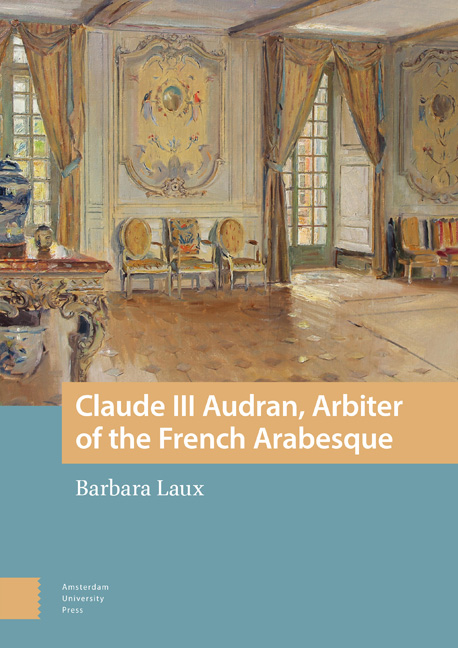Book contents
- Frontmatter
- Contents
- List of Illustrations
- Acknowledgements
- Introduction
- 1 Biography of Claude III Audran (1658–1734)
- 2 The French Arabesque as an Art Form, Audran as Master Ornamentalist , and His Initial Commissioned Works
- 3 Claude III Audran and Jean de La Fontaine’s Fables: Maintaining the Social Hierarchy
- 4 Attracting New Patrons in the Eighteenth Century
- 5 Claude III Audran’s Competitors and His Legacies
- Color Plates
- Appendix
- Bibliography
- Index
- Frontmatter
- Contents
- List of Illustrations
- Acknowledgements
- Introduction
- 1 Biography of Claude III Audran (1658–1734)
- 2 The French Arabesque as an Art Form, Audran as Master Ornamentalist , and His Initial Commissioned Works
- 3 Claude III Audran and Jean de La Fontaine’s Fables: Maintaining the Social Hierarchy
- 4 Attracting New Patrons in the Eighteenth Century
- 5 Claude III Audran’s Competitors and His Legacies
- Color Plates
- Appendix
- Bibliography
- Index
Summary
Abstract
An Audran ceiling preserved in the Musée des Arts Décoratifs introduces the reader to the artist Claude III Audran. A brief description of his artform, the arabesque, follows. This is the first study to analyze Audran's accomplishments and the longevity of his successful career. Audran acted as a vital connection between the Maîtrise and the Académie royale while earning renown for his painted arabesques. The chapters follow the arc of Audran's career and consider the contextual variables that influenced and shaped his work. Audran's achievements bridge an important period with the eclipse of the Maîtrise artist and the rise of the Académie royale. A review of previous scholarship contributes to our understanding of Audran's oeuvre.
Keywords: Ornamentalist; Hôtel particulier; Commission; Cronstedt
In a small oval gallery at the Musée des Arts Décoratifs in Paris, the beautifully lit vitrines draw the immediate attention of many of its visitors. As a consequence, they might fail to notice the gallery's ornate painted ceiling, which was designed in 1725 by Claude III Audran (1658–1734) and preserved from an eighteenth-century Paris mansion, the Hôtel de Verrue (Plate 1). A gilded frieze of singerie, playful monkey figures dressed and imitating human behavior, set against a blue background borders an interior field of arabesque designs. The ease with which the identification of this ceiling can be overlooked typifies the underappreciation of Audran's oeuvre despite a career spanning nearly forty years, from the 1690s until his death.
During this period, Claude III Audran played a critical, yet largely overlooked, role in the development of Rococo design to suit the elite tastes of the period. He created a new kind of ornamentation that updated the grotesque, a form of ancient Roman painted ornament featuring fantastic animals and decorative elements that was rediscovered in the Italian Renaissance. His designs tapped into topical motifs instead of the propagandistic themes of absolutism conveyed in design from Louis XIV's early decades. French decorative style changed from the severity of the Baroque to the light, whimsical aesthetic of the Rococo, and Audran's work in its entirety reflects this evolution of elite taste. Audran achieved artistic and enduring professional success due to his creation of arabesque ornament, which blended venerable motifs with those drawn from popular culture into a sort of generic hybridization.
- Type
- Chapter
- Information
- Claude III Audran, Arbiter of the French Arabesque , pp. 13 - 30Publisher: Amsterdam University PressPrint publication year: 2024

